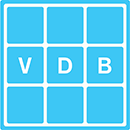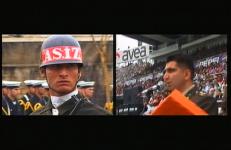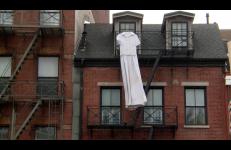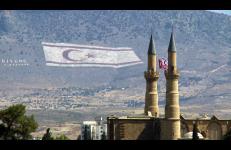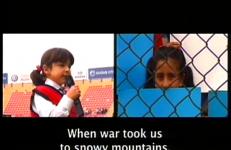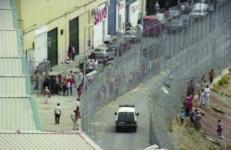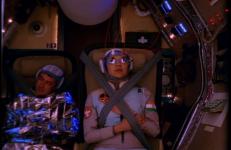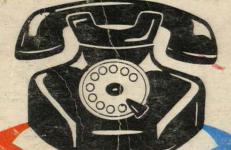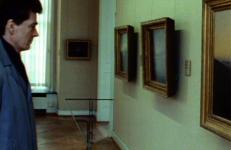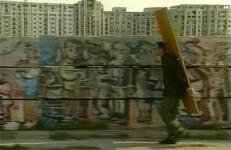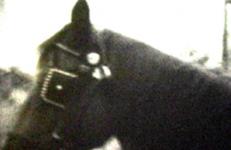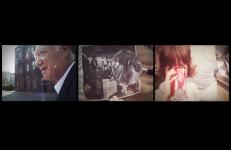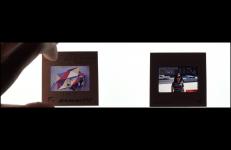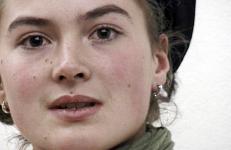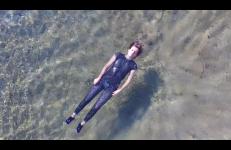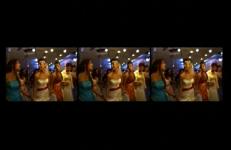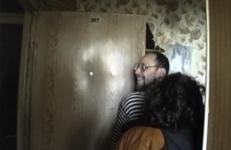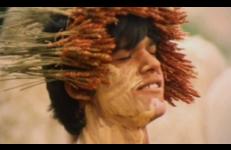"I, Soldier is the first part of a video series in which I am dealing with the state-controlled ceremonies for the national days of the Turkish Republic. The nationalistic attributes attached to these large-scale ceremonies are underlined in a non-descriptive and almost voyeuristic point of view. I, Soldier was shot at the National Day for Youth and Sports; the day that marks the start of the independence war of the Turkish public under the leadership of Mustafa Kemal Atatürk, against the Allied Forces back in 1919.
Eastern European
THE DRESS: is a projection prop created for a performance piece at the Art Institute in 1984. It was installed in March 2021, suspended in front of a building on the Bowery as both a memorial to my grandmother, a Hungarian immigrant and master seamstress, and to the Triangle Shirtwaist Factory fire, of 1911, which occurred a few blocks north of this site.
-EJay Sims
THE DRESS: is a projection prop created for a performance piece at the Art Institute in 1984. It was installed in March 2021, suspended in front of a building on the Bowery as both a memorial to my grandmother, a Hungarian immigrant and master seamstress, and to the Triangle Shirtwaist Factory fire, of 1911, which occurred a few blocks north of this site.
-EJay Sims
The Turkish national anthem, regularly sung in schools on Mondays and Fridays, is recorded with Super-8 and video to capture the fragile links that tie young citizens to nationhood.
This title is only available on Radical Closure.
John Smith’s Flag Mountain records a vast flag, the insignia of the Turkish Republic of Northern Cyprus, painted onto the side of the Kyrenia mountains overlooking Nicosia, the divided capital of the former island nation. The flag, situated in what is officially understood under international law to be 'Turkish occupied' northern Cyprus, is accompanied by the legend 'Ne mutlu Türküm diyene' ('How happy is he who can say “I am a Turk”').
"The Flag is the second part of a video series about the state-controlled national day ceremonies of the Turkish Republic. Shot during the April 23rd Children’s Day celebrations, which mark the establishment of the new Turkish Parliament, and hence the official demise of the Ottoman Empire back in 1920, this split screen film documents a pompous patriotic performance devised by elders to be performed by children.
The third in a film triptych, Lefkosia was shot from within UN controlled territory on the border between south Cyprus and the Turkish occupied North. Like the previous two parts, this episode explores the landscape’s composition along the current borders of Europe. It presents a silent camera traveling along a heavily guarded border, where even photography is forbidden without permission.
This title is only available on Radical Closure.
"Finn seamlessly blends actual space footage with his own lovingly handcrafed and carefully art directed scenes of Eastern Block cocktail parties, field hockey teams and space capsules. With a propulsive, playful score by Jim Becker and Colleen Burke, as well as likely the strangest version of "The Trolley Song" ever recorded, the film is an endearing delight."
--Mark Olsen, Indiewire
It's not my memory of it is a documentary about secrecy, memory, and documents. Mobilizing specific historical records as memories which flash up in moments of danger, the video addresses the expansion and intensification of secrecy practices in the current climate of heightened security. A former CIA source recounts his disappearance through shredded classified documents that were painstakingly reassembled by radical fundamentalist students in Iran in 1979.
It's not my memory of it is a documentary about secrecy, memory, and documents. Mobilizing specific historical records as memories which flash up in moments of danger, the video addresses the expansion and intensification of secrecy practices in the current climate of heightened security. A former CIA source recounts his disappearance through shredded classified documents that were painstakingly reassembled by radical fundamentalist students in Iran in 1979.
"Persistence was shot in 1991-92 in Berlin, and edited with films by U.S. Signal Corps cameramen in 1945-46, obtained from Department of Defense archives. Interspersed through these materials are filmic quotations from Rossellini's Germany Year Zero (1946). A meditation on the time just after a great historical event, about what is common to moments such as these—the continuous and discontinuous threads of history—and our attachment to cinematic modes of observation that, by necessity, shape our view of events.
Susan Mogul's first video diary work, produced two years before Everyday Echo Street: A Summer Diary (1993), follows the artist on a trip though Eastern Europe immediately after the fall of the USSR. Through discussions with various characters about politics, art, and each others personal lives, Mogul creates a video time capsule of social life in Poland, then Czechoslovakia, and former Yugoslavia.
With sampled image and sound sequences referring to one another in a precisely calculated rhythmic alternation on four projection surfaces, Călin Dan draws a portrait of the city of Bucharest. Dilapidated tower blocks next to estates of terraced houses, Roma families camping with their horses and carts in the wastelands in the midst of the city, broken streets and new shopping paradises--today the formerly communist Bucharest is a city in upheaval, full of social contradictions and oppositions.
A young communist girl named Sharambaba resists her suitor in a carriage. She speaks of what he calls her "fantasy world". All of the dialogue is played backwards with accommodating subtitles.
This title is also available on Jim Finn Videoworks: Volume 1.
A collision of separate pasts, this film pieces together fragments of the director's own images and text from a 1991 visit to the East German town of Halle with those produced by Bauhaus painter Lyonel Feininger in 1931. A meditation on emotional memory, the film interrogates the ability of images to document personal history.
This Was Home is comprised of three channels, which present three generations of the artist’s family. On one screen Levy presents her maternal grandfather, Karl Ribstein, another shows her father, Yossi Levy, and the third presents the artist herself. Levy documented each of these protagonists on a journey back to their childhood city and to the home where they grew up, which they had not revisited since having to leave it in their childhood.
Trip is inspired by the main oeuvre of architect Raine Karp--the concert hall designed for the city of Tallinn between 1975-1980. Considered the most important building realized in Estonia, Linnahall is a time capsule preserving the utopian ideas of centralized power and of egalitarian modernism, and an example of how architecture can stir public emotions in our times of corporate dominance.
Trip is inspired by the main oeuvre of architect Raine Karp--the concert hall designed for the city of Tallinn between 1975-1980. Considered the most important building realized in Estonia, Linnahall is a time capsule preserving the utopian ideas of centralized power and of egalitarian modernism, and an example of how architecture can stir public emotions in our times of corporate dominance.
This project started with an email from a stranger in 2017. The sender was the widower of the late artist Tania and he invited the filmmaker to look at her “archive.” Tania was born to Jewish parents in Poland in 1920. The family moved to Paris in the 1930s, but during the WWII they fed to Montreal, then emigrated to New York. Tania eventually became an artist. While facing many hurdles as a female artist in the 1960s and 70s, Tania vigorously created a wide range of artworks, not only paintings and three-dimensional pieces, but also public art projects.
Produced in former Yugoslavia (Bosnia-Herzegovina, Croatia, Macedonia, Serbia & Montenegro, Slovenia), Austria, USA, Canada, 1999-2003.
Every country employs specific techniques for disguising its soldiers, every army has developed its own camouflage uniforms. Croatia is one of the few countries in the world that uses a digitized shape of its own territory in its camouflage military design. Why? The question is not meant to be answered by human reason. It does not relate to the perception of human eyes. Night vision cameras, binoculars, heat detectors and drones have their own ways of seeing the world.
"Wedding takes its name from the predominantly Turkish neighborhood in Berlin where most of the footage of the film has been recorded. During the course of six months in 2006-2007, I have recorded the wedding ceremonies of Turkish and Kurdish immigrants in Berlin, which culminated in a large video archive. From this archive I have created a three-channel video piece.. But the experiences I have gathered during the course of this project and the archive later led me to include this subject in my current PhD thesis, on cultural performances, and crowd theory."
It was 1990 and, although the iron curtain was falling, Soviet official control was still iron-fisted. Camcorder reporter Skip Blumberg went along with a group of art aficionados on a tour of the Moscow studios of the unofficial artists, an underground community of talented, courageous and often wacky conceptual artists. His report reveals an insider’s view of the art world and, at the same time, is a video about making a video.
The result of a three-year project with inmates from a high security prison in Romania, Wings for Dogs is an essay about language and its capacity to simultaneously communicate and hide issues connected to guilt and responsibility.
